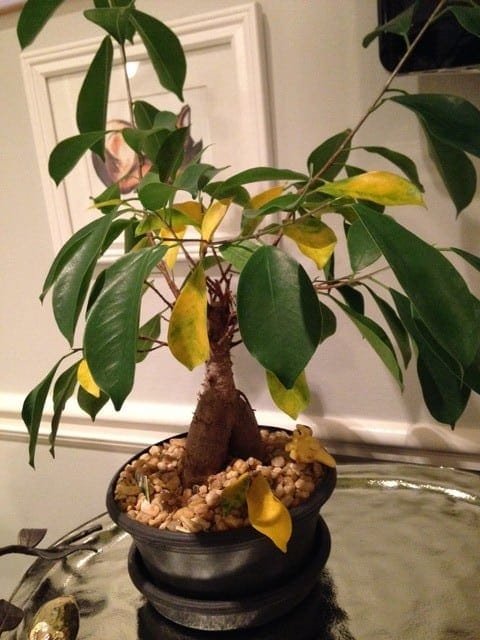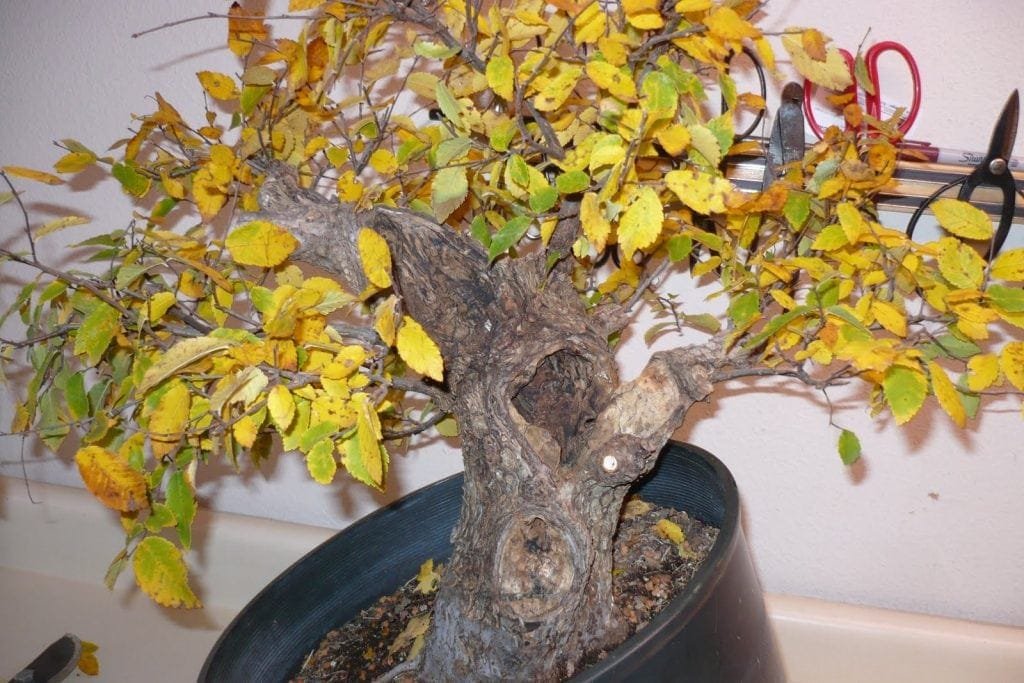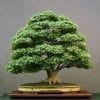Bonsai trees are regular trees that have been structurally designed to grow small. These miniature trees grow like regular trees and therefore require the care and attention of regular trees need. And because bonsai trees are just miniaturized versions of regular trees, these are also prone to different diseases and conditions that regular trees suffer from.
One of the most common conditions that bonsai growers deal with when growing bonsai is yellowing of the leaves of the tree. Although some yellowing is normal, this condition becomes very alarming when many leaves turn yellow. Sometimes yellowing becomes very persistent which could again be very disheartening especially for first-time growers. So how do you really deal with bonsai trees when leaves turn yellow? Here are some time-tested techniques.

What you need to follow this tutorial
- Bonsai tree afflicted with yellowing of the leaves
This is any kind of bonsai tree that has been affected by yellowing of the leaves. Aside from yellowing, some bonsai trees may even experience drying and falling of leaves that have turned into yellow.
- Balanced fertilizer
Your bonsai trees need a balanced N-P-K fertilizer to be able to meet its nutritional demands, especially during its developmental stages.
- Bonsai Pot
Your bonsai tree needs the ideal bonsai pot to grow in. No matter what type of pot or planter you want to use, it has to have adequate drainage holes. You can purchase bonsai pots from local bonsai shops and nurseries.
- Water
You need clean water to give to your bonsai trees. Regular bonsai trees usually can do with just tap water or rainwater while some trees need distilled water to grow.
- Thermometer
Bonsai trees need the ideal environmental or room temperature to grow. There is no specific temperature reading to follow but it’s best to use a thermometer to better gauge the temperature in a particular room or environment.
Step by step instructions

Here is step by step instructions on how to manage to yellow of bonsai tree leaves. Because there is a large variety of trees which can be made into bonsai, reasons for the yellowing of bonsai leaves could vary as well. A careful study of the type of tree you wish to turn into bonsai will help you treat any condition that may affect your plant. Studying the kind of tree you want to work with will also let you understand its growing needs, training needs, and its developmental stages as well.
1) Find out what makes bonsai tree leaves turn yellow
- Underwatering
Underwatering is one of the top reasons why tree leaves turn yellow. The yellowing of the leaves in this situation is generalized and may be accompanied by wilting, drying and crumpling of the leaves.
Water is one of the basic needs of growing plants. Just like humans, plants have a large percentage of water in their bodies and this is used in many natural processes. Without water, these natural processes will never be accomplished. Plants would fail to produce food and this will affect their overall growth and development.
Underwatering will not just lead to yellowing of leaves. If plants continue to receive less and less water, these can ultimately die.
- Stress
Bonsai is just like other plants. These can feel and become affected by stressful situations. There are many ways that plants become stressed. Drastic changes in its growing environment or transferring from indoor to outdoor growing, mishandling during re-potting, wiring and pruning and drastic changes in the temperature of the growing environment could all lead to stress.
- Mineral deficiencies
A number of trees are sensitive to changes in nutrients in the soil. The absence or the abundance of some nutrients could affect the health of the tree and this is observed by changes in leaf color among other symptoms.
Nutrient deficiencies and toxicities are usually reversible. Correcting nutrient deficiencies and toxicities will be able to save bonsai trees but this should be done quickly otherwise these could be detrimental to bonsai plants.
- Exposure to cold
Some bonsai trees are very sensitive and any changes in temperature could affect its growth and development. Exposure to a cold environment is one of the most common reasons why leaves turn yellow. Drastic moving of bonsai trees from a warm outdoor environment to an air-conditioned room can trigger yellowing of the leaves. Returning the plant to its regular environment will not reverse leaves color but will only stop the progression of the discoloration.
If you are unsure about the reason why your bonsai tree is suffering from yellowing of the leaves, it’s best to rule out one reason after another until you arrive at the correct one. For instance, you know that your plants were not subjected to any stress or drastic temperature changes for the past days and you have not changed its fertilizer formula then you may be underwatering your trees.
2) Get to know the type of tree or species of tree you are trying to grow

Growing bonsai is not merely taking a tree and trimming, pruning and wiring it. This is a living and growing thing; a bonsai tree needs the right care and attention which can only be provided when you do your own research.
Take note that there is a large number of trees that can be made into a bonsai. You can turn evergreen trees, conifers, tropical trees or deciduous trees into bonsai. Given this vast variety of trees, each one has its specific growing needs. You can’t simply follow the growing technique you used in one tree to care for another one.
- Check online bonsai tree growing sites for important information about the type of tree you wish to grow.
- Ask fellow bonsai growers for some tips on how to grow the specific type of tree you want to turn into bonsai.
- Learn about special bonsai growing techniques from bonsai masters and leading people when it comes to bonsai growing.
- Visit a local nursery and ask the proprietor for tips and strategies
3) Give your bonsai the ideal fertilizer or nutrients

As nutrient toxicities and deficiencies can lead to leaf discoloration, you must learn about the specific nutrients that your bonsai tree needs to grow healthy and strong. Once you understand the type of nutrient your tree needs, you will be able to correct these imbalances easily.
- Flush your system before correcting imbalances
Before correcting any kind of imbalance, you must flush out the soil you are using. Use distilled water to water your bonsai. Let water run off the sides of the pot to completely soak the soil. Let this dry before watering or adding new nutrients to correct any imbalance. Flushing your system will also help remove toxins and mineral salts that may be affecting the absorption of nutrients that your plants need hence the discoloration.
- Correcting nutrient imbalances
Correcting any kind of imbalance is done by either adding more nutrients or reducing the kind of nutrient. Special fertilizer formulas are given to plants that need a specific nutrient. You may also use a nutrient to reduce the amount of another nutrient like calcium and potassium. Naturally, when potassium levels are higher, calcium levels are lower. Correcting any imbalance becomes easier when you understand the relationship among nutrients.
But how do you know what kind of nutrient is needed to be added or reduced? A simple soil test can be done. This will identify the nutrient that’s causing an imbalance using a small kit. A soil sample kit can help you out. This is readily available from local gardening shops or site.
- Using a balanced fertilizer
Almost all trees need a balanced fertilizer to be applied on a regular basis. This type of fertilizer can be used to correct an imbalanced system and hence can end leaf discoloration.
Fertilizers contain nutrients nitrogen, potassium and phosphorous which are essential to overall tree health and development. Keeping all these ingredients balanced is essential to trees.
Remember, when using fertilizer, use an only fertilizer that is recommended for the type of tree that you want to grow. Use the fertilizer according to instructions found on the label. If you have questions about the ingredients or how the fertilizer is applied to your bonsai trees, contact the manufacturer. And of course, use only organic fertilizer to ensure plant health.
- Use fresh soil for repotting
Bonsai trees are planted in very small containers which could only contain a small amount of soil. Naturally, the tree could use up all these nutrients even before a specific season is over. The trick is to change the soil regularly as you re-pot trees. Use organic potting soil instead of regular soy. This type of soil does not contain any kind of component that can cause nutrient imbalances and will be more beneficial to your plants.
- Provide the ideal planter or pot for bonsai growing
Most of the time you did not intend to overwater your bonsai but it simply happened! Same goes for nutrient toxicities. The culprit is in the type of planter you are using for your bonsai. You can use any kind of planter or pot but make sure that you use planters and pots that have adequate drainage.
This type of pot should have at least holes at the sides and at the bottom of the pot. With these, you can easily drain excess water and nutrients. Drainage holes will also allow oxygen to pass through and benefit plant roots. Hence, adequate drainage holes in bonsai planters can save the life of your bonsai trees.
4) Water your bonsai tree regularly

Each type of tree has its own watering requirements. But no matter what, your bonsai trees need adequate water to be delivered on a regular basis. Overwatering could be detrimental to plants because you are letting excess water stand in the roots. This can lead to root rot and the development of molds a well. So how do you correctly water bonsai trees?
- Water only when the soil is high and dry. If despite using the right pot or planter and fewer watering still causes overwatering and discoloration on plants then you can try this strategy. Dry the soil with a fan or by carefully placing the plant in a shaded area in your backyard.
- Use the right pot or planter on your bonsai tree. The right planter has adequate drainage holes to allow excess water to drain out of the soil.
- Water your plants good, clean water
Make sure that your water supply is clean and free of toxins and salts that can affect the flow of water and nutrients to plants. Ideally, using distilled water can bring good health to trees because this has a balanced formula that is readily absorbed by plants.
If possible, have your water supply tested if you spot any discoloration on your leaves. Water testing kits are available from local garden sites. You may also ask a professional to test your water.
5) Manage bonsai tree stress

Bonsai trees may suffer from stress and this can lead to changes in its appearance as well as its ability to grow and develop good leaves, stems, and branches. Stress could be any form. It could be due to re-potting, pruning, picking, wiring or any activity that counters the plant’s daily schedule.
- When pruning or pinching trees, do so when the tree is in perfect health. Your tree should be free from diseases, pests, leaf discoloration, nutrient imbalances and anything that can affect its health.
- When wiring, wire only trees that are in good state of health and also young and pliable trees. Wiring young and pliable branches are easier and less stressful to trees because the branches may still be softer and easier to work with. You will be able to prevent any injury to your tree when you wire it at an early age.
- Use the appropriate techniques to the wire and prune bonsai. Follow guidelines on how to manipulate your trees and how to prune trees and you won’t have to worry about plant stress. Just some simple rules to remember when pruning and wiring bonsai trees include
- Prune when the tree is in its dormant stage. This is applicable for coniferous trees.
- Prune using sterile or clean shears or cutter to prevent the spread of diseases and molds.
- Prune trees that are healthy and not those that have diseases and nutrient imbalances.
- Prune only trees that have settled in their pots to prevent stressing your plants
- Wire plants when these are in their growing phase and if possible, remove the wire during the same season it was attached. Removing during the same season will prevent severe injuries to your plant since wires can eat through the bark and this can lead to irreparable damage.
- After wiring or pruning, let your plants rest by allowing to recuperate in a shaded area of your garden. Water it regularly and never overfeeds
- After pruning or wiring, monitor the health of your trees. Take note of how well or how poorly products have done for the past years.
6) Maintain the ideal growing temperature for your bonsai tree
Never move a bonsai tree to an area where it’s cooler or too much warmth. If you need to move a tree, slowly do it. Let the tree acclimate first to the temperature of the growing environment.
Use a room thermometer to be able to maintain the right room temperature and avoid sudden changes in temperature.
Understand the growing position of each tree before you even start growing one. Despite growing indoors, you still need to be aware of the temperature that your trees need daily.
Keep in mind
Yellowing may be due to a number of reasons but despite correcting these reasons, these won’t reserve the condition but instead prevent it from happening or progressing. Your leaves won’t return to its natural green color but instead will simply wilt and fall. Sometimes correcting an imbalance takes a lot of time. Be patient with your bonsai. Your plants will be able to recover when you follow these techniques, therefore, give it time.
Monitor your plant’s health. You can write a growing bible or a growing guide for different bonsais or you can take a photo of your plant’s progress. This is a good idea especially when you want to share your bonsai growing tips to others.
Conclusion
Yellowing of the leaves of bonsai plants could be due to many factors. It could be because of overwatering, nutrient deficiencies, stress, and cold environments. Bonsai trees are just like regular trees in the sense that these can recover from yellowing by following simple strategies to treat leaf discoloration. When you follow these techniques, you will be able to care for your bonsai trees without the fear of any discoloration or condition which can affect your plant’s overall health and development.


